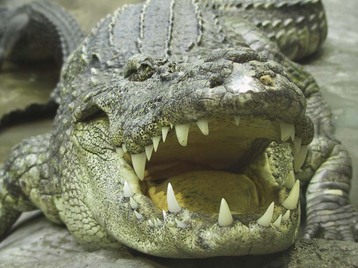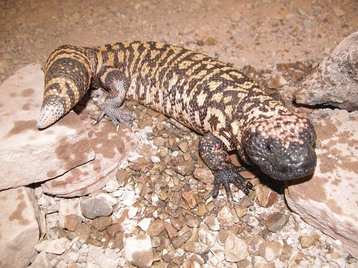141 Non-Snake Reptile Bites
• Alligator and crocodile bites may inflict significant internal injury and should be managed as major trauma.
• Gila monster bites may leave teeth in the wound that are not visible by radiography.
• Patients with a Gila monster bite should be observed for 8 hours after the bite because of the risk for systemic toxicity.
• The Komodo dragon has joined the Gila monster and the beaded lizard as the only known venomous lizards of medical significance; its bites are known to cause hypotension and coagulopathy, in addition to infections.
• Green iguanas and snapping turtles may carry Salmonella.
• Delayed wound closure and prophylactic antibiotics should be considered in all patients with reptile bites.
Epidemiology
Crocodilians account for more human injuries and fatalities worldwide than any other non-snake reptile. Three of the largest species are known for unprovoked attacks on humans: the American alligator (Alligator mississippiensis), the saltwater crocodile (Crocodylus porosus), and the Nile crocodile (Crocodylus niloticus). From 1928 through 2008, 567 reports of adverse encounters with American alligators resulted in 24 deaths in the United States. Most injuries were due to a single bite.1,2 In Australia, 80% of unprovoked attacks by the saltwater crocodile involved people who were either swimming or wading in water. The Nile crocodile of Africa, though smaller and less territorial, probably accounts for more human fatalities than all other 23 species of crocodilians combined.3
Most Gila monster bites are nonaccidental and occur as a result of handling the reptile. Accidental bites have become exceedingly rare. No deaths from Gila monster bites have been reported in the United States in the past 50 years.4,5 The Komodo dragon is now known to have a venom apparatus similar to that of the Gila monster, and deaths have been reported as a result of their bites.
Crocodilians
Pathophysiology
Crocodilians survived the Ice Age and are the dominant predators in many of the world’s tropical waterways. The American alligator may be found in the southeastern United States, from North Carolina to Louisiana. The saltwater crocodile is found in Southeast Asia and Australia, with males reaching lengths of up to 23 feet (7 m). Victims of crocodilian attacks sustain trauma from a combination of penetrating, blunt, and sheer force. The saltwater crocodile can generate 2000 psi when it bites. The sheer magnitude of the jaw muscle force sustained with extensive penetrating injuries devitalizes large areas of tissue, thereby making such injuries slow to heal and susceptible to infection. Bites must be considered to be heavily contaminated with multiple bacteria, including Aeromonas hydrophila, Pseudomonas, and Proteus (Fig. 141.1).
Presenting Signs and Symptoms
Crocodilian bites are characterized by punctures and tears. Their teeth are conical and not designed for chewing but for grasping their prey. Among survivors, the extremities were the most commonly injured site, with less than 10% sustaining torso trauma.3,6 Crocodilians may also roll their entire body (known as the “death roll”) to disorient and drown the victim, as well as to tear pieces from the victim’s body.3 The force of the massive jaws may lead to extensive internal injury, but even when bite wounds are not present, the force of the animal’s movement—or even blunt trauma from its tail—may also inflict significant internal trauma. Initial survivors of severe attacks may exhibit hypotension from massive hemorrhage, in addition to respiratory distress from submersion injury.
Differential Diagnosis and Medical Decision Making
![]() Priority Actions
Priority Actions
Reptile Bite Wounds
Treat all victims of crocodilian bites as major trauma patients with the potential for massive internal injuries.
Extremity bites should be evaluated for underlying vascular, tendon, nerve, or bone injury.
Copiously irrigate and débride all wounds, especially crocodilian and Komodo dragon bites.
Facial wounds and others with significant cosmetic concern should be closed if the patient is seen early after the bite and does not show signs of infection.
Consider a 5-day course of prophylactic antibiotics with close outpatient follow-up to monitor for signs of infection.
Gila Monster and Beaded Lizard
Pathophysiology
The Gila monster (Heloderma suspectum) and the closely related beaded lizard (Heloderma horridum) are native to the southwestern United States and Mexico but may be found throughout the world in zoos and as illegal pets. They are characterized by black beadlike scales mixed with bandlike patterns of yellow, white, or pink scales (Fig. 141.2). These reptiles typically range in length from 9 to 32 inches (22 to 81 cm); the beaded lizard is the larger of the two species.
Stay updated, free articles. Join our Telegram channel

Full access? Get Clinical Tree








